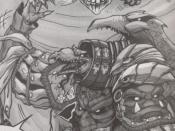With its "animatronics" technology, Jim Henson's 1982 film, The Dark Crystal, in both form and theme depicts key elements of David Leeming's description of the hero myth's rites of passage in The World of Myth: An Anthology. As in Leeming's rites of passage, in this film the protagonist's heroic experiences lead him to "wholeness" and "full individuation" (220). At the formal level, by concealing puppet strings, providing puppets with exceptionally life-like and fluid motions, and creating convincingly vital puppets, Henson's detail-rich and realistic animatronics technology allows his puppet-hero, Jen, to grow both beyond his filmic father figure, urSu, as well as beyond the confining puppet strings of the traditional puppet master. Thematically, too, Jen experiences the rites of "[being] born when . . . needed" (218), of being "call[ed] to adventure" (219), and of being faced with trials and danger (219), that Leeming discusses as making up the passage into individuation.
As Leeming describes, heroes are born when the need for them arises; this usually happens during a dark period in the culture's history (218). In The Dark Crystal, Jen, who belongs to a nearly extinct race known as Gelflings, is born after the Crystal is cracked and a shard of it is lost. As with Leeming's "dark period," the events initiated by the crystal's shattering mark the end of a period of light; here the thousand years of the green and goodness of the land once maintained by the Crystal become darkness and ugliness once the crystal is shattered. This dark period is also marked by the claiming of the land by the cruel and evil race of Skeksis. Making this period of the hero's emergence in the film even darker, the Skeksis, in their attempt to avoid fulfillment of the prophecy that a Gelfling would destroy them,


